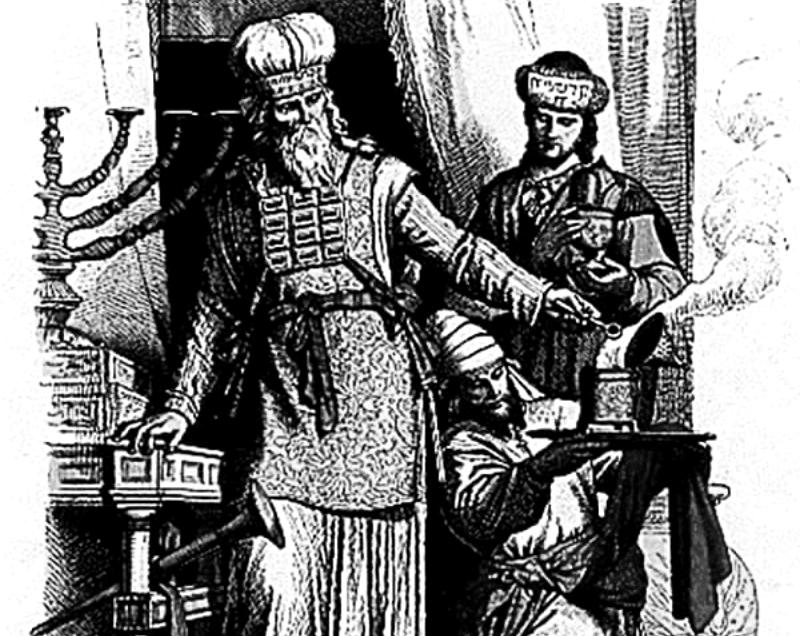Our text describes the consecration ceremony of Aaron and his sons Nadab, Abihu, Eleazar, and Ithamar, to serve the Blessed One. This ceremony consists of a series of animal sacrifices and vegetable offerings, and the anointing of both Aaron and his four sons.
On one hand, this anointing, or sprinkling, is done with the blood of animal sacrifice. First on the ear, then the thumb of the hand and the thumb of the foot. All three on the right side of the body (Shemot, 29:20).
Once this blood has been anointed, the rest is thrown around the altar of the Mishkan. Then Moses —because it’s him who does all this work— Moses takes a measure of this blood and some of the oil that he had previously deposited on the altar. Makes a small sprinkling on Aaron and his garments, and the clothes of his children: “sprinkle it upon Aaron and upon his garments, upon his sons and upon the garments of his sons with him; thus he will become holy along with his garments, and his sons and their garments with him” (Shemoth, Exodus, 29:21).
The ram of the sacrifice is described as “of perfection” [מִלֻּאִ֖ים] (verse 22). Later, in verse 29, the Torah tells us that “the holy garments that are Aaron’s shall be for his sons after him, to be exalted through them and invested with full authority through them”, [וּלְמַלֵּא־בָ֖ם אֶת־יָדָֽם]. That we could translate literally as “filling or establishing their hands,” that is, strengthening his authority.
After all this hand play we find in today’s fragment, with the anointing of the fingers of the right hand; the act of placing the whole offering “on the palms of the hands of Aaron and his sons” (verse 24); then take the offering “out of his hands” and consume it completely (verse 25); strengthening the hands and authority of Aaron and his sons, Sforno tells us something very interesting! Of all the ceremonies we see, what makes the High Priest what he is, is not the sacrifice of “perfection” or consecration. It’s the garments. “[…] to be exalted through them and invested with full authority through them.” Because although Aaron presents this first sacrifice of consecration, his children and successors will not have to present it again (Ovadiah ben Jacob Sforno, Commentary on the Torah, translated and commented on by Rabbi Raphael Pelcovitz, p. 440).
As in the previous parashah, one thing is the idea or concept, and another is how you aply it. One thing is the position and the authority that it entails. A very different one is the person who exercises it. The sanctity of the figure of the High Priest resides in the garments. Once Aaron — or Eleazar, Phinehas, and the rest of his successors — dresses and exercises (with his right hand) becomes the High Priest. The position remains the person changes. It’s good to remember that from time to time.
En el nostre text d’avui es descriu la cerimònia de consagració d’Aaron i els seus fills Nadab, Abihu, Eleazar i Ithamarper servir al Sant, beneït sigui. Aquesta cerimònia consisteix en una sèrie de sacrificis animals i ofrenes vegetals, i la unció tant d’Aaron com dels seus quatre fills.
Per una banda, aquesta unció, o aspersió, es fa amb la sang del sacrifici animal. A l’orella, al polze de la mà i al polze del peu. Tots tres de la part dreta del cos (Xemot, Èxode, 29:20).
Un cop s’ha ungit aquesta sang, la resta es llença al voltant de l’altar del Mixkàn. Seguidament, Moisès —perquè tota aquesta operació la fa ell—, Moisès pren una mida d’aquesta sang escampada, i una mica de l’oli que prèviament havia dipositat a l’altar, i fa una petita aspersió sobre Aaron i les seves vestimentes, i també sobre les vestimentes dels seus fills: «ell i les seves vestidures, i els seus fills i les vestidures dels seus fills amb ell, esdevindran kadoix [santes]» (Xemot, Èxode, 29:21).
El marrà del sacrifici es descriu com «de perfecció» [מִלֻּאִ֖ים – miluim] (vers 22). Més endavant, al vers 29, la Torah ens diu que «els vestits sants que són d’Aaron seran pels seus fills després d’ell, per a ser exaltats a través d’ells i investits amb tota autoritat a través d’ells», [וּלְמַלֵּא־בָ֖ם אֶת־יָדָֽם – uL’mala-bam et-iadam]. Que podríem traduir literalment com «omplir o establir les seves mans», és a dir afermar la seva autoritat.
De tot el joc de mans que trobem al fragment d’avui, amb la unció dels dits de la mà dreta, el fet de posar tota l’ofrena «als palmells de les mans d’Aaron i dels seus fills» (vers 24), per després treure l’ofrena «de les seves mans» i consumir-la per complet (vers 25) i afermar les mans i l’autoritat d’Aaron i els seus fills, Sforno ens explica una cosa interessantíssima! De tota la cerimònia que hem vist, el que fa que el Gran Sacerdot sigui el que és no és el sacrifici «de perfecció» o de consagració. Són els vestits. «[…] per a ser exaltats a través d’ells i investits amb tota autoritat a través d’ells». Perquè malgrat que Aaron presenta aquest primer sacrifici de consagració, els seus fills i successors no l’hauran de tornar a presentar (Ovadiah ben Jacob Sforno, Commentary on the Torah, traduït i comentat per Rabí Raphael Pelcovitz, p. 440).
Com a la paraixà anterior, una cosa és la idea o el concepte, i una altra com s’aplica. Una cosa és el càrrec i l’autoritat que comporta, i una molt diferent és la persona que l’exerceix. La santedat de la figura del Gran Sacerdot resideix en les vestidures, un cop la persona, Aaron —o Eleazar, Pinhàs i la resta dels seus successors— es vesteix i exerceix, amb la mà dreta, esdevé el Gran Sacerdot. El càrrec roman, la persona canvia. Està bé recordar-ho de tant en tant.








Ohr HaChaim Yomi – Emor